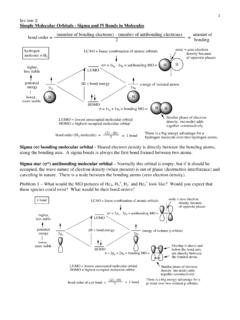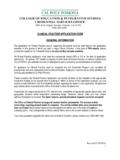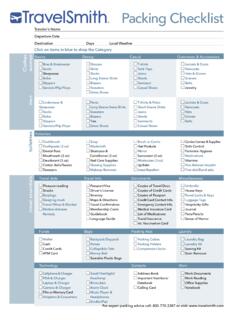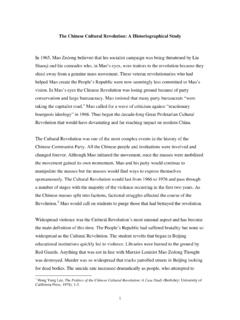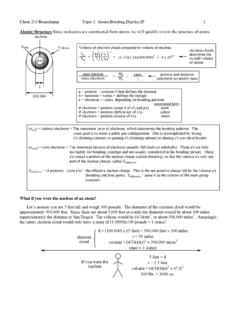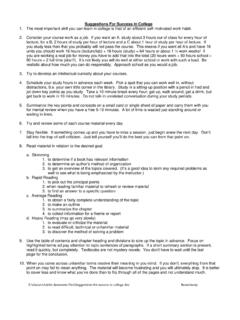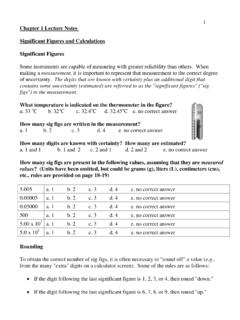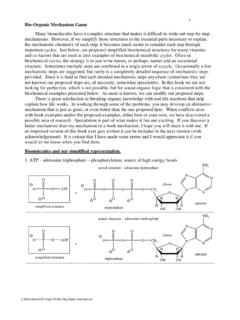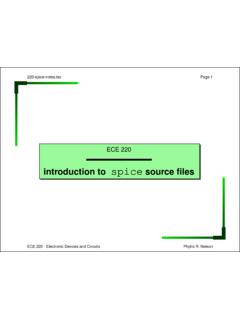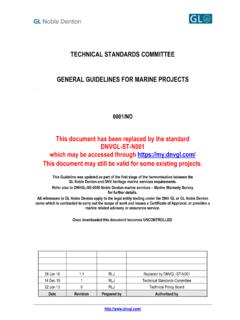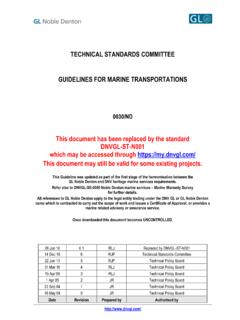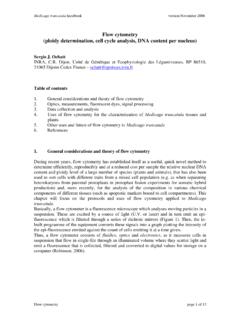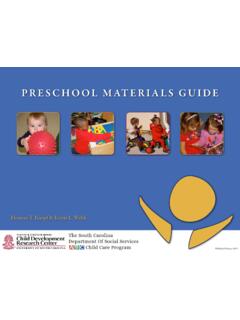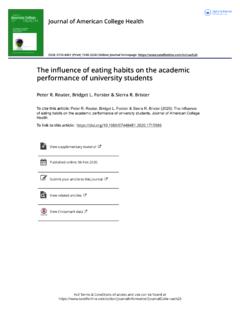Transcription of I.Title: Three Philosophies of China: Daoism, Confucianism ...
1 : Three Philosophies of China: daoism , Confucianism and BuddhismII. Rational:In order to understand the economic and political China of today, it is important thatwe understand the Chinese mind. In order to understand the Chinese mind it is imperativethat we understand the the Three most important Philosophies that constitute the Chineseculture. These are the Philosophies of daoism , Confucianism and Buddhism. This unitshould be considered as springboard into other units on Chinese culture. With somebackground of these Philosophies , students should obtain a deeper understanding andappreciation of subjects such as Chinese food, art, and Student Goals:This unit will provide the students an opportunity to explore the ideas of Lao Tzu,Confucius and the the Buddha.
2 Students will learn about their lives and what they studentwill be able to read sections from the Three books that each of thesephilosophers inspired. However, it is important that the teacher realize that any instructionin historical philosophy - especially eastern philosophy - will be difficult for many studentsas well as adults. Therefore, after completing this unit it is not important that the studentshave a deep understanding of the concepts of these Philosophies . Rather this unit is meantto be more of an introduction to Chinese Philosophies , The students will be introduced tothese Three great philosophers and have an opportunity to work with their Outcomes:By working together and individually the students will be able to:1.
3 List the Three philosophers that influenced the Chinese mind,2. identify the 3 books fromwhich we can read their teachings,3. have an opportunity to read selections from these philosophers in order to obtain a flavor of language and complexity of their ideas,4. have an opportunity to actually work with these ideas by matching phrases from these Three books to the Primary Sources:1. The Dao De Ching - Lao Tzu2. The Analects - Confucius3. "The Sutra of Turning the Wheel of Dharma"4. The DhamapadaVI. Historical and Philosophical Context:In order to understand the Chinese culture, it is important that the Three influentialphilosophies found in China be discussed. These Three Philosophies are:1. Daoism2. Confucianism3.
4 Is not to say that only these Three Philosophies make up the Chinese mind. Norwould it be correct to say that a Chinese personwould adhere to just one of thesephilosophies exclusively. Rather one should see these Three principle philosophiescombined into one belief system that is termed the must important philosopher in the Chinese culture is was born in 551 when China was going through political turmoil. As ayoung man, still in his twenties, he became a tutor of several disciples. However, he stillwished to hold public office. At the age of fifty, he began a thirteen year journey goingfrom province to province offering his service to the various rulers. He had no offers. Atthe end of his life he was finally offered a position in his home province of Shantung, butby that time he was too old.
5 He spent the remaining years of his life teaching and editingthe great Chinese classics. He died at the age of 73 in the year of 479 Although henever reached his political goals, he is today considered to be one of the world's lived in a time in Chinese history known for its political problems andgovernmental cruelty. He tried to solve this problem of this government instability bystating that harmony could be found in the ancient ways of the founders of the ChouDynasty. Confucius called this time the Age of Grand Harmony. He believed that the keyto harmony was education. The family, temples, schools, government all were tools bywhich moral ideals were passed on to the individual. He reinforced certain Chinese ethicssuch as (1) social and political concerns, (2) importance of family, (3) reverence for theelders (4) ritual and (5) the value of TzuDaoism begins with the ancient philosopher Lao Tzu who said to have been born inChina around 604 Most of what we know about Lao Tzu comes to us in the formof legends of which some are unbelievable while others are more realistic.
6 One story statesthat he was a keeper of archives in western China and lived an unassuming life. At the endof his life he was disenchanted with his people's lack of interest in developing the naturalgoodness that he was advocating. He left for a life of meditation in what is now Tibet. AtHanako Gate a guard tried to convince him to return to China but failed. However, theguard did convince Lao Tzu to write his philosophy. Lao Tzu spent Three days writing a5000 character book which is now known as the Dao De Ching or The Way to work is still regarded as the definitive text in daoism , the most essential concept is that of the dao. We can understand the daoin Three ways. First, dao is the ultimate reality - it is so large and complicated it can not beunderstood.
7 It is transcendent. Secondly, dao can be described as the way of the is the way the universe and the laws of nature act. Finally, dao is the way of human is this aspect of dao that has the greatest impact for the Chinese culture - but it can not beseen as the only aspect of this , daoism divided into Three different schools of which two are important forour understanding of this philosophy. According to Houston Smith in his book, Religionsof the World, these two schools of thought can be classified as philosophical and religiousDaoism. The major difference between these two schools is the idea of the dao itself. Inphilosophic daoism the dao is something to be controlled and expended wisely. This typeof daoism called School daoism inChina seeks wisdom in order to and conserve it ratherthan expend it on useless conflicts.
8 It emphasizes the concept of wu wei which meansinaction or pure effectiveness. Smith states: "Action in the mode of wu wei is action inwhich friction - in interpersonal relations, interphysic conflict and in relation to nature isreduced to the the other hand in religious daoism , the dao is to be increased. In religiousDaoism the idea of ch'i is important. It literally means breath but it also refers to energy. Toreceive more ch'i is to remove things that block it. This can be done by working in threeways: matter, movement and minds. From matter the idea of nutrition and medicinal herbsbecome important. The exercise t'ai chi and acupuncture relate to the concept of the area of mind, Daoist mediation developed. Over time daoism becameinstitutionalized into a religion.
9 (Around the 2nd century CE. Lao Tzu became a "god." )BuddhaOf the Three Philosophies discussed in the following lessons, the only one is notinherently Chinese is Buddhism. Buddhism began in India around 560 BCE with theteaching of Siddhartha Gautama who upon his enlightenment was called the "the Buddha."which means the "awakened one." His teaching traveled into China along the famous silkroute around 200 For the next several hundred years Buddhism slowly developed inChina through the work of Indian and Chinese monks that traveled to and from India withthe Buddhist teachings. Over time Buddhism developed into a major religious philosophyin China with as many as eight different schools of Buddhism of which Ch'an (Zenmeditation) and Pure Land ( chanting a Buddha's name) still exist basic belief of Buddhism is the Four noble Truths and the Eightfold Path.
10 Thefirst noble truth is the admission that life is suffering. (Note the term suffering has adifferent connotation in the language of the Buddha. It means out of kilter or not quiteright.) The second noble truth is that the cause of suffering is desire, greed ignorance andattachment. The Buddha gives a way to end suffering in the third noble truth which is toend desire, ignorance and attachment. The fourth noble truth tells how to end desire. Thismodel is laid out in eight steps called the Eightfold Path. These guidelines are rightunderstanding, right views, right speech, right effort, right livelihood, right behavior, rightconcentration and right Number of Class Sessions:Class Sessions: 3 to 8 The lessons that follow are meant to be supplementary to the basicsixth grade uniton China.
